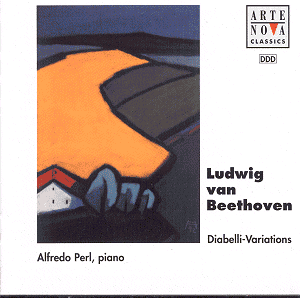 |
Ludwig van BEETHOVEN (1770-1827)
Crotchet
AmazonUK
AmazonUS |
When the minor Viennese composer Anton Diabelli set up his new music publishing house in 1823, he conceived the idea of offering a theme of his own on which other composers could write a variation, thus building up a composite work for the piano. Among those who supported the scheme with variations were the eleven-year-old Franz Liszt, Beethoven's pupil, the Archduke Rudolph, Mozart's son Franz Xaver, and Franz Schubert.
In truth Beethoven, his thirty sonatas now behind him, had little need for such a scheme, though he took up what he described as Diabelli's 'cobbler's patch' of a tune, to provide the basis for a full set of no fewer than thirty-three variations of his own. In the process he created the longest and greatest of all his various sets of piano variations. During the final phase of his life, variation form held a special fascination for Beethoven, as witnessed in the piano sonatas, the string quartets and the Choral Symphony. Indeed, the final movement of the last Piano Sonata (opus 111) has many subtle links with the Diabelli Variations.
With a performing time approaching an hour, it is clear that the Diabelli Variations represent one of the supreme challenges to any pianist, encompassing technique, inspiration, concentration and structural command. Perl scores strongly on every count, and an intrepid reviewer or listener who wonders about the level of concentration in the later stages needs of necessity to consider his own response to the challenge before questioning that of the artist. Beethoven - and Perl - sets out his stall in the very first variation, as the waltz rhythm is replaced by a majestic and powerful formality, while the next group gradually build on the clear outline of the theme, until a climax is released at variation seven. All this is splendidly achieved, with the aid also of a resonant yet clear recording from Arte Nova, which originally came from Radio Bremen. Although the performance was first issued in 1995, it has only now become readily available in the U.K.
It has been worth the wait, for this is a performance in keeping with the nature of Beethoven's conception. From the opening sequence, the scale of the conception is unequivocally stated; and with a performing time of some fifty minutes the music must necessarily range widely. There are abundant harmonic subtleties and a dramatic exploitation of every possibility offered by the basic material. If there is a criticism of Perl's playing - and it can only be a relative criticism - it is that the slower sections might project a more singing line, with more flowing phrasing. Try comparing him with Alfred Brendel, for example.
Both in tempo and texture the variations extend to every conceivable mood and style, as garnered by Beethoven during the course of a long creative career. Most remarkable of all, perhaps, is the caricature (Variation No. 23) of Leporello's 'Notte e giorna faticar' from Mozart's Don Giovanni, which treats both Diabelli and Mozart with equal truth and imagination. In the later stages the tempo slows and the minor key is more thoroughly exploited than before, culminating in an expressive Largo variation (No. 31) which releases a strong fugue in Beethoven's heroic key of E flat. With abundant subtlety Perl allows this climactic passage to release the final variation, a moderately paced and somewhat ethereal minuet, which in due course is abruptly closed by a single forte chord.
At the bargain Arte Nova price there is no question that this disc offers excellent value.